Ghostbusters
8 /10 1 Votes8
97% Rotten Tomatoes Language English | 7.8/10 IMDb 67% Metacritic Genre Comedy, Fantasy Duration | |||||||||||||||||||||||||||||||||
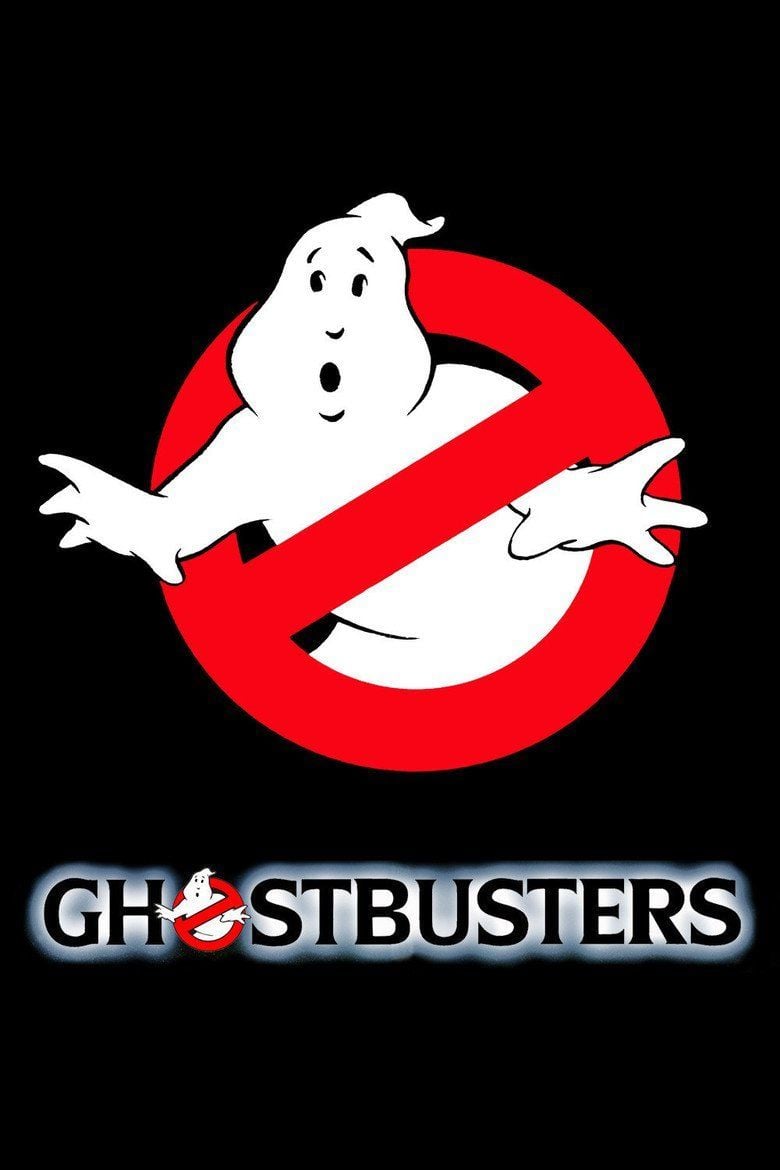 | ||||||||||||||||||||||||||||||||||
Release date June 7, 1984 (1984-06-07) (Westwood, California)June 8, 1984 (1984-06-08) Cast (Dr. Peter Venkman), (Dr. Raymond Stantz), (Dana Barrett), (Dr. Egon Spengler), (Louis Tully), (Janine Melnitz) Characters Egon Spengler (Harold Ramis), Peter Venkman (Bill Murray), Ray Stantz (Dan Aykroyd), Winston Zedde (Ernie Hudson), Janine Melnitz (Annie Potts) Similar movies Tagline They ain't afraid of no ghost. | ||||||||||||||||||||||||||||||||||
Ghostbusters official trailer hd
Ghostbusters is a 1984 American supernatural comedy film directed and produced by Ivan Reitman and written by Dan Aykroyd and Harold Ramis. The film stars Bill Murray, Aykroyd and Ramis as eccentric parapsychologists who start a ghost-catching business in New York City. Sigourney Weaver and Rick Moranis co-star as a client and her neighbor, and Ernie Hudson as the Ghostbusters' first recruit.
Contents
- Ghostbusters official trailer hd
- Original ghostbusters theme song
- Plot
- Cast
- Development
- Pre production
- Casting
- Filming
- Box office
- Critical response
- Accolades
- Home media
- Re releases
- Paperback novelizations
- Soundtrack
- Personnel
- Score
- Critical reception
- Sequel and reboot
- Legacy
- References
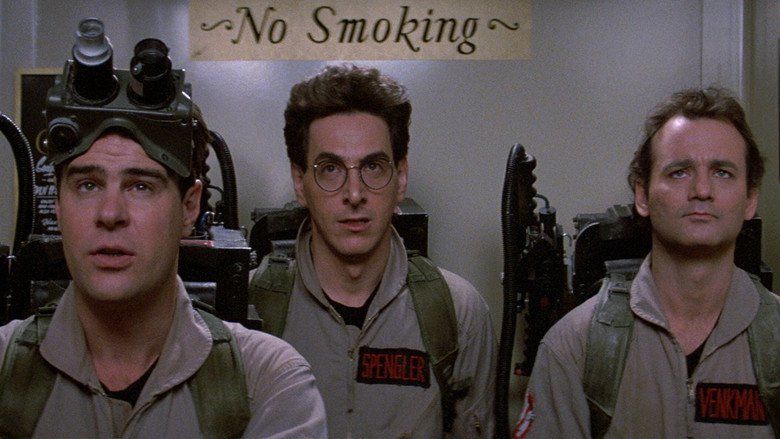
Aykroyd conceived the film as a project for himself and fellow Saturday Night Live alumnus John Belushi, with the "Ghostmashers" travelling through time and space in the future with magic wands. He and Ramis dramatically rewrote the script following Belushi's death and after Reitman deemed Aykroyd's initial vision financially impractical.
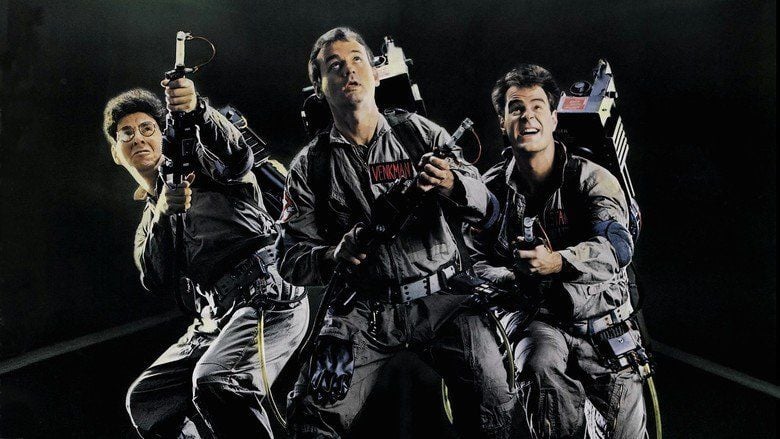
Ghostbusters was released in the United States on June 8, 1984. It received a positive response from critics and audiences and grossed $242 million in the United States and more than $295 million worldwide. It was nominated for two Oscars at the 57th Academy Awards for Best Visual Effects and Best Original Song (for the eponymous theme song), but lost to Indiana Jones and the Temple of Doom and The Woman in Red respectively.
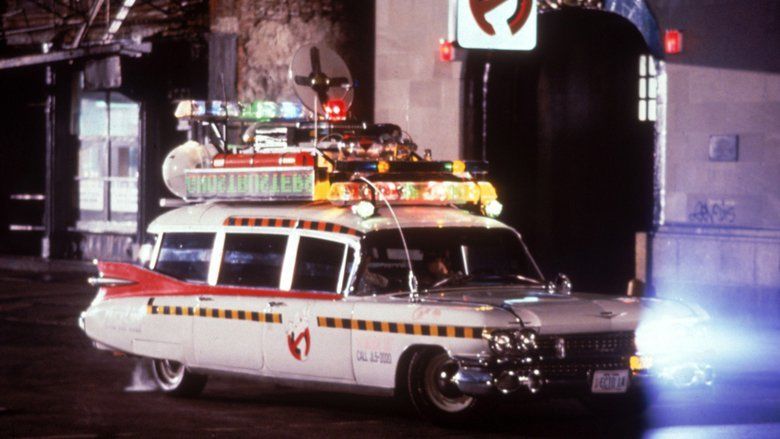
The American Film Institute ranked Ghostbusters 28th in its AFI's 100 Years...100 Laughs list of film comedies. In 2015, the United States Library of Congress selected the film for preservation in the National Film Registry, finding it "culturally, historically, or aesthetically significant".

The film launched a media franchise, which includes a 1989 sequel, Ghostbusters II, two animated television series, The Real Ghostbusters and Extreme Ghostbusters, several video games and a 2016 reboot film.

Original ghostbusters theme song
Plot
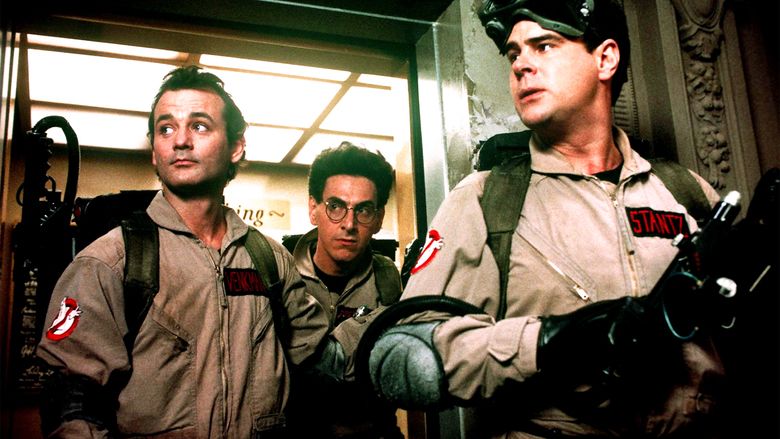
Parapsychologists Peter Venkman, Raymond Stantz, and Egon Spengler are called to the New York Public Library to investigate recent paranormal activity. They encounter the ghost of a dead librarian but are frightened away when she transforms into a horrifying monster. After losing their jobs at Columbia University, the trio establish a paranormal investigation and elimination service known as "Ghostbusters". They develop high-tech equipment capable of capturing ghosts and open their business in a disused, run-down firehouse. Egon warns them never to cross the energy streams of their proton pack weapons, as this could cause a catastrophic explosion. They capture their first ghost, Slimer, at a hotel and deposit it in a specially built containment unit in the firehouse basement. As paranormal activity increases in New York City, they hire a fourth member, Winston Zeddemore, to cope with demand.

The Ghostbusters are retained by cellist Dana Barrett, whose apartment is haunted by a demonic spirit, Zuul, a demigod worshipped as a servant to Gozer the Gozerian, a Sumerian shape-shifting god of destruction. Venkman takes a particular interest in the case, and competes with Dana's neighbor, accountant Louis Tully, for her affections. As the Ghostbusters investigate, Dana is demonically possessed by Zuul, which declares itself the "Gatekeeper", and Louis by a similar demon, Vinz Clortho, the "Keymaster". Both demons speak of the coming of the destructive Gozer and the release of the imprisoned ghosts, and the Ghostbusters take steps to keep the two apart.
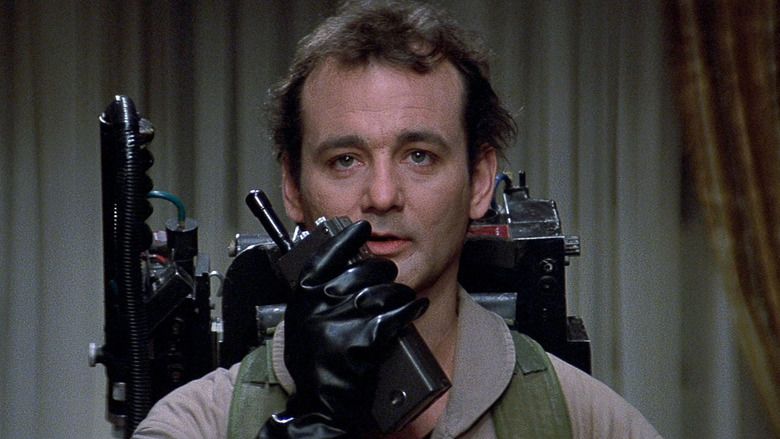
Walter Peck (William Atherton), a lawyer representing the Environmental Protection Agency, has the Ghostbusters arrested for operating unlicensed waste handlers and orders their ghost containment system deactivated, causing an explosion that releases hundreds of ghosts. The ghosts wreak havoc throughout the city while Louis/Vinz advances toward Dana/Zuul's apartment. Consulting blueprints of Dana's apartment building, the Ghostbusters learn that mad doctor and cult leader Ivo Shandor, declaring humanity too sick to deserve existing after World War I, designed the building as a gateway to summon Gozer and bring about the end of the world.
The Ghostbusters are released from custody to combat the supernatural crisis. As they trudge up 22 flights of stairs in Dana's building, a romantic encounter between Zuul and Vinz Clortho opens the gate between dimensions and transforms them into supernatural hellhounds. After reaching the roof, the team is unable to prevent the arrival of Gozer, who appears in the form of a woman. Briefly subdued by the team, Gozer disappears, but her voice echoes that the "destructor" will follow, taking a form chosen by the team. Ray inadvertently recalls a beloved corporate mascot from his childhood—"something that could never, ever possibly destroy us"— and the destructor arrives in the form of a giant Stay Puft Marshmallow Man and attacks the city. The Ghostbusters cross their proton pack energy streams (reversing the particle flow) and fire them against Gozer's portal; the explosion destroys Stay Puft/Gozer and frees Dana and Louis. As thousands of New Yorkers wipe themselves free of marshmallow, the Ghostbusters are welcomed on the street as heroes.
Cast
Development
The movie's concept was inspired by Dan Aykroyd's fascination with the paranormal. Aykroyd conceived it as a vehicle for himself and his friend and fellow Saturday Night Live alumnus John Belushi. The original story, as written by Aykroyd, was very different from what was eventually filmed. In the original version, a group of "Ghostsmashers" traveled through time, space, and other dimensions combating huge ghosts (of which the Stay-Puft Marshmallow Man was one of many). They wore SWAT-like outfits and used wands instead of proton packs to fight the ghosts. (Original storyboards show them wearing riotsquad-type helmets with movable transparent visors.) In addition to a similar title, the movie shares the premise of professional "exterminators" on a paranormal mission with The Bowery Boys slapstick comedy Spook Busters (1946, directed by William Beaudine) as well as with the 1937 Disney short Lonesome Ghosts. Lonesome Ghosts includes the line "I ain't scared of no ghost".
Aykroyd pitched his story to director/producer Ivan Reitman, who liked the basic idea but immediately saw the budgetary impracticality of Aykroyd's first draft. At Reitman's suggestion, Aykroyd and Ramis gave the story a major overhaul, writing the final screenplay during a three-week stay in a Martha's Vineyard bomb shelter in May–June 1982.
Pre-production
Notable illustrators hired by associate producer Michael C. Gross to provide storyboards and concept art envisioning the ghosts and other psychic phenomena encountered by that film's characters included Thom Enriquez, Bernie Wrightson, and Tanino Liberatore. John DeCuir, who was known for his elaborate sets, was hired as Production designer/Art director, which Reitman considered a coup, as he wanted the film's visuals to tell a story using architectural cues. Ghosts that were visualized as puppets were built by Boss Films, which also handled compositing of special effects shots.
In the story, the ghost-hunting weapons wielded by the Ghostbusters, or "proton packs", consisted of a portable cyclotron worn as a backpack by each Ghostbuster, capable of releasing a stream of directed protons through a neutrona wand, or proton gun, which counteracts the "negatively-charged ectoplasmic energy" of a ghost or similar creature. The packs were designed by Design consultant Stephen Dane, who "went home and got foam pieces and just threw a bunch of stuff together to get the look. It was highly machined but it had to look off-the-shelf and military surplus." The actual fiberglass props used by the actors were created by special effects supervisor Chuck Gaspar, based on Dane's design. Gaspar used rubber molds to create identical fiberglass shells, attached them to aluminum back plates and Army surplus ALICE (All-purpose Lightweight Individual Carrying Equipment) frames. Each pack weighed about thirty pounds (14 kg), and nearly fifty (22.6 kg) with the batteries installed, and strained the actors' backs during the long shoots. Lightweight packs made of foam rubber were used for stunt work. The PKE meter prop was built using an Iona SP-1 handheld shoe polisher as a base, to which lights and advanced-looking electronics were affixed.
The Ghostbusters' vehicle, the Ectomobile, was in the first draft of Aykroyd's script, and visualized through concept drawings by John Daveikis. Early versions of it were jet black, and featured more fantastic features, such as the ability to dematerialize and evade police pursuit. The vehicle used for the Ectomobile during filming was a modified 1959 Cadillac Miller-Meteor with an aftermarket ambulance conversion. Stephen Dane created its high-tech roof array in Hollywood with various objects including a directional antenna, an air-conditioning unit, storage boxes and a radome. Because of its size, the roof rack was shipped to Manhattan via airplane, while the car had to be transported to the East Coast via train. Sound designer Richard Beggs created the car's distinctive siren from the snarl of a leopard, cut and played backward.
Casting
Aykroyd and Ramis initially wrote roles especially for Belushi and John Candy. However, Belushi died before the screenplay was completed, and Candy would not commit to the project, so Aykroyd and Ramis made further changes that were reflected in the film's production. Candy would later appear in the music video for the film's theme song.
Louis Tully was originally conceived as a conservative man in a business suit to be played by comedian Candy; but Rick Moranis instead portrayed Louis as a geek. Gozer was originally to appear in the form of Ivo Shandor, a slender, unremarkable man in a suit, played by Paul Reubens. However the role ultimately went to Yugoslav model Slavitza Jovan. The demonic voice of Gozer was provided by Paddi Edwards.
According to Ernie Hudson, an earlier version of the script had his character, Winston, in a larger role with an elaborate backstory as an Air Force demolitions expert. Excited by the part, he agreed to the job for half his usual salary. The night before shooting began, he was given a new script with a greatly reduced role; Reitman told him the studio had wanted to expand Murray's role. In a 2015 article for Entertainment Weekly, Hudson wrote: "I love the character and he’s got some great lines, but I felt the guy was just kind of there. I love the movie, I love the guys. I’m very thankful to Ivan for casting me. I’m very thankful that fans appreciate the Winston character. But it’s always been very frustrating—kind of a love/hate thing, I guess."
Filming
Filming of exterior scenes began in Manhattan in late October 1983. Among the locations that granted permission for filming was Columbia University, which allowed its Havemeyer Hall to stand in for the fictional "Weaver Hall", on the condition that the University not be identified by name. The Irving Trust Bank on Fifth Avenue served as the bank where Aykroyd's character takes out a third mortgage to provide the Ghostbusters' startup money. The exterior shots of the Ghostbusters headquarters were of the Firehouse, Hook & Ladder Company 8 in Manhattan's Tribeca neighborhood. The building at 55 Central Park West served as Dana Barrett and Louis Tully's apartment building, increased eight stories via matte painting by John DeCuir. Other Manhattan locations used for exteriors included the New York Public Library, Columbus Circle, the Waldorf-Astoria Hotel and the Tavern on the Green restaurant in Central Park where Tully falls prey to one of the demonic "Terror Dogs".
Locals complained about the imposition on their neighborhoods. John DeCuir said: "They had one night to dress the street. When people went home early in the evening everything was normal, and when the little old ladies came out to walk their dogs in the morning, the whole street had erupted. Apparently people complained to the New York Police Department and their switchboard lit up." During filming of the scenes set at Dana Barrett and Louis Tully's apartment building at 55 Central Park West, Aykroyd ran into science fiction writer Isaac Asimov, whom Aykroyd idolized; Asimov demanded to know if Aykroyd was responsible for the traffic jam caused by the street closures between 61st and 67th Streets. When Aykroyd admitted that he was, Asimov replied, "It's disgusting." Despite this, Daniel Wallace, author of Ghostbusters: The Ultimate Visual History, states, "Infectious energy was everywhere. The upbeat vibes seemed to buoy the production schedule, and the New York shoot finished two-and-half days earlier than expected." Weaver said:
"I think it was a love letter to New York and New Yorkers. Central Park West, and Tavern on the Green, and the horses in the park, and the doorman saying, 'Someone bought a cougar to a party'–that's so New York. When we come down covered with marshmallow, and there are these crowds of New Yorkers of all types and descriptions cheering for us as a New York–it was one of the most moving things I can remember."
Interior scenes were shot at Burbank Studios (now the Warner Bros. Studios). The interiors of the Los Angeles Central Library stood in for the basement of its New York counterpart seen in the film's opening. Downtown Los Angeles' decommissioned Fire Station No. 23 was chosen for the interior of the Ghostbusters' headquarters because its interiors seemed visually consistent with the exterior of the Tribeca firehouse. The Millennium Biltmore Hotel stood in for the scenes set at New York's Waldorf-Astoria. One exterior scene shot in Manhattan enhanced with supplemental work in Los Angeles was the earthquake scene in front of Dana Barrett and Louis Tully's building in the story's climax. While the shot of the Ghostbusters and other New Yorkers falling down was filmed on location, the shots of the street cracking were achieved with hydraulics used on a Los Angeles soundstage.
The "marshmallow" that rained down on the crowd cheering the Ghostbusters on at Dana Barrett's building after Gozer was destroyed was shaving cream. After a test run with 75 pounds of shaving cream knocked a stunt man flat, only 35 pounds were used for the final shot with Atherton.
Box office
Ghostbusters was released on June 8, 1984, in 1,339 theaters. It grossed $13.6 million on its opening weekend and $23 million in its first week, setting studio records at the time. The film was number one at the box office for five consecutive weeks, grossing $99.8 million. After seven weeks, it was finally knocked to the number-two position by Prince's film Purple Rain, at which point it had grossed $142.6 million, second only to Indiana Jones and the Temple of Doom as the year's top moneymaker. Remarkably, Ghostbusters then regained the top spot the next week, and again six weeks later. It went on to gross $229.2 million, making it the second highest-grossing film of 1984, behind only Beverly Hills Cop. Adjusted for inflation, these figures put it within the top 40 highest-grossing films of all time. Box Office Mojo estimates that the film sold over 68 million tickets in the US in its initial theatrical run. A 1985 re-release raised the film's United States gross to $238.6 million ($531 million in today's dollars), surpassing Beverly Hills Cop and making it the most successful comedy of the 1980s.
Critical response
Ghostbusters received overwhelmingly positive reviews from both critics and audiences and is considered by many as one of the best films of 1984. It holds a 97% "Certified Fresh" approval rating on review aggregation website Rotten Tomatoes, based on 67 reviews; the site's consensus called the film "an infectiously fun blend of special effects and comedy, with Bill Murray's hilarious deadpan performance leading a cast of great comic turns". On Metacritic, the film has a score of 67 out of 100, based on 7 critics, indicating "generally favorable reviews".
Film critic Roger Ebert gave the film three and a half stars out of four and wrote, "This movie is an exception to the general rule that big special effects can wreck a comedy ... rarely has a movie this expensive provided so many quotable lines." Newsweek magazine's David Ansen wrote, "Everyone seems to be working toward the same goal of relaxed insanity. Ghostbusters is wonderful summer nonsense." In his review for TIME, Richard Schickel praised the three lead actors: "Of the ghost wranglers, the pair played by writers Aykroyd and Ramis are sweetly earnest about their calling, and gracious about giving the picture to their co-star Bill Murray. He obviously (and wisely) regards Dr. Peter Venkman as a once-in-a-lifetime opportunity to develop fully his patented comic character."
Pauline Kael had problems with the chemistry among the three lead actors: "Murray is the film's comic mechanism ... but nobody else has much in the way of material, and since there's almost no give-and-take among the three men, Murray's lines fall on dead air." In her review for The New York Times, Janet Maslin wrote, "Its jokes, characters and story line are as wispy as the ghosts themselves, and a good deal less substantial."
Accolades
The film received two Academy Award nominations, including Best Original Song (for the hit song "Ghostbusters") and Best Visual Effects (John Bruno, Richard Edlund, Chuck Gaspar and Mark Vargo). The film was nominated for two Golden Globes: Best Motion Picture – Musical or Comedy and Best Actor – Motion Picture Musical or Comedy (Bill Murray).
The American Film Institute ranked it 28th in its list of the top 100 comedies of all time (in their 100 Years... 100 Laughs list).
In 2006, Bravo ranked Ghostbusters 76 on their 100 Funniest Movies list. Entertainment Weekly ranked it as the "Funniest Movie of the Past 25 Years."
In 2008, Empire magazine ranked the film #189 on its list of The 500 Greatest Movies of All Time. In 2009, National Review magazine ranked Ghostbusters number 10 on its "25 Best Conservative Movies of the Last 25 Years" list.
Home media
Ghostbusters was released on VHS, Betamax, Laserdisc, and CED in 1985 months after the film was rereleased in theatres. The stereo soundtrack for the VHS transfer was reversed from right to left; the soundtrack was corrected in future editions of the film. It was reissued on VHS in 1987. In 1989, Criterion Collection released a LaserDisc version of the film, in a one-disc CLV version and a two-disc special edition CAV version. The latter included deleted scenes, a split-screen demonstration of the film's effects, the screenplay, and other special features. Director Ivan Reitman was not happy with the LaserDisc release of the film because "it pumped up the light level so much you saw all the matte lines. I was embarrassed about it all these years." It was released on VHS in 1990 as part of a VHS box set that included Ghostbusters II. It was released again on VHS in 1994, and in 1996 as part of the Columbia TriStar Family Collection. The DVD version of the movie was released on June 29, 1999, at a time when an estimated four million U.S. households had DVD players, and became one of Reel.com's fastest selling products.
Sony announced at Comic-Con 2008 that the Blu-ray version of the film would be released on October 21, 2008. Sony initially made it available through their promotional website Ghostbustersishiring.com. The movie was released on Blu-ray on June 16, 2009, to coincide with the film's 25th Anniversary. Ghostbusters was the first film ever officially released on a USB flash drive. A second Blu-ray version, released on May 14, 2013, was marketed as "Mastered in 4k".
Re-releases
Sony Pictures re-released the film in nearly 500 theaters in the United States on October 13, 2011, and the following two Thursdays before Halloween of that year.
Sony reissued a remaster in 4K version for its 30th anniversary on August 29, 2014. Originally a one-week re-release for the U.S. Labor Day, it ran for three weeks ending on September 18.
The film was again re-released on June 8 and 12, 2016, to generate publicity for the 2016 remake of the film. It was shown in over 800 theatres and included footage from the remake.
Paperback novelizations
Unusually, there were two separate "adult" novelizations of the first film to coincide with its release in two separate markets. In the US, Tor Books published one adaptation of the screenplay by Richard Mueller. In the UK, Coronet Books published the other, written by Trevor Hoyle under the pseudonym "Larry Milne." Each represents the screenplay faithfully, but they are stylistically quite different. Mueller's is written in standard past tense and expands upon the main characters with light internalization. Hoyle's is written in present tense, like the screenplay, and puts a proportionately greater emphasis on rhythm and pace.
The sequel film novelization, for both markets, published by Dell Books in the US, was written by Ed Naha.
Soundtrack
The soundtrack to Ghostbusters was released on LP in 1984 by Arista Records. The film's theme song, "Ghostbusters", written and performed by Ray Parker, Jr., sparked the catchphrases "Who you gonna call? Ghostbusters!" and "I ain't afraid of no ghost." The song was a huge hit, staying at number one for three weeks on the Billboard Hot 100 chart and for two weeks on the Black Singles chart, and brought Parker an Academy Award nomination for Best Original Song. According to Bruce A. Austin (in 1989), the theme "purportedly added $20 million to the box office take of the film".
In autumn of 1984, singer and songwriter Huey Lewis sued Ray Parker, Jr. for plagiarism, claiming that Parker copied the melody from his 1984 song "I Want a New Drug". Lewis had been approached to compose the main theme song for the movie, but declined due to his work on the soundtrack for Back to the Future. The two musicians settled out of court. It was reported in 2001 that Lewis allegedly breached an agreement not to mention the original suit, doing so on VH1's Behind the Music.
The music video produced for the song became a number-one video on MTV. Featuring actress Cindy Harrell, directed by Ivan Reitman, produced by Jeffrey Abelson, and conceptualized by Keith Williams, the video integrated footage of the film with a humorous performance by Parker. It also featured cameo appearances by celebrities who joined in the call-and-response chorus, including Chevy Chase, Irene Cara, John Candy, Melissa Gilbert, Ollie E. Brown, Jeffrey Tambor, George Wendt, Al Franken, Danny DeVito, Carly Simon, Peter Falk, and Teri Garr. The video concludes with Parker and the stars of the film, in full Ghostbuster costume, dancing and singing behind Parker in Times Square.
Sony gained rights to the film's soundtrack when its music division Sony Music Entertainment acquired the Arista catalog via 2004 Bertelsmann Music Group joint venture and 2008 BMG buyout from Sony.
Personnel
Score
The film score was composed by Elmer Bernstein, and is notable for its use of ondes Martenot (a staple of Bernstein's 1980s work) and also the Yamaha DX7 synthesizer. Orchestrators contributing to the film were Peter Bernstein, David Spear and Patrick Russ. The score was commercially released in 2006 as Ghostbusters: Original Motion Picture Score by Varèse Sarabande. It contains 39 tracks by Bernstein, including several cues that were replaced in whole or in part by songs, and the four pieces that Bernstein specially recorded for the soundtrack album ("Ghostbusters Theme," "Dana's Theme," and the previously unreleased "Magic" and "Zool"). Bernstein understood the decision to supplant his opening and some of the closing credit music with the Ray Parker Jr. song, but disliked that tactic being used with other parts of the score, particularly with "Ghosts!" (written for the scene where the ghosts are released) being replaced with Mick Smiley's "Magic."
Critical reception
Reviewers at AllMusic have awarded both the Original Soundtrack Album and the Original Motion Picture Score 4 out of a total 5 stars. Evan Cater describes the Original Soundtrack Album somewhat pejoratively as "a very disjointed, schizophrenic listen" that "does very little to conjure memories of the film". However, he notes that there are exceptions to this, namely Ray Parker Jr.'s title track "Ghostbusters", Mick Smiley's "Magic", and the two inclusions from Elmer Bernstein's score. Jason Ankeny describes the Original Motion Picture Score as "epic in both sound and scale", noting that it "ranks among Bernstein's most dazzling and entertaining efforts, evoking the widescreen wonder of its source material", concluding that "his melodies beautifully complement the wit and creativity of the onscreen narrative."
Sequel and reboot
After the success of the first film and the animated series The Real Ghostbusters, Columbia Pictures pressured the producers to make a sequel. However, Aykroyd, Ramis and Reitman were uncomfortable with this, as the original film was intended to be conclusive and they wished to work on other projects. Eventually, they agreed and created a script. The second film, Ghostbusters II, was released in 1989.
A script for a potential third film was under development by Gene Stupnitsky and Lee Eisenberg, the writing team that worked with Ramis on the 2009 comedy Year One; according to Ramis, the four main cast members from the original film were potentially to have minor on-screen roles: "The concept is that the old Ghostbusters would appear in the film in some mentor capacity." Comments from Murray in August 2010, after Year One's release suggested the latter's poor reception made a new Ghostbuster sequel unlikely. Two months later, Aykroyd downplayed Murray's comments, saying Stupnitsky and Eisenberg "wrote Bill the comic role of a lifetime, and the new Ghostbusters and the old are all well represented in it"; they wrote a "strong first draft" that Aykroyd and Ramis would work on. In February 2012, Aykroyd said, "The script must be perfect. We cannot release a film that is any less than that. We have more work to do."
On February 24, 2014, Ramis died, causing Sony Pictures to re-evaluate the script that they were writing for Ghostbusters III. Sony was planning on starting production in New York early in 2015, but Reitman decided to pull out of directing the film in light of Ramis's death. Reitman, however, will help to find a new director. It was revealed on March 20, 2014, that Phil Lord and Chris Miller were in talks to direct the film, but by April 8, 2014, the duo had decided to pass on the project. On May 30, 2014, The Wrap reported that Ruben Fleischer is being considered to direct the third film. Weaver told Vanity Fair that her character's son, Oscar, would be a Ghostbuster in the film.
On August 2, 2014, The Hollywood Reporter revealed that the studio wanted Paul Feig to direct the film and wants to make it an all female Ghostbusters team. On September 17, 2014, Aykroyd told The Hollywood Reporter that he wants to do a Ghostbusters-style universe as what Marvel did with their own universe. On October 8, 2014, The Hollywood Reporter announced that screenwriter Katie Dippold and director Paul Feig would be writing the script.
On December 10, 2014, both Rebel Wilson and Jennifer Lawrence revealed they were approached for a role in the reboot, while Emma Stone, Melissa McCarthy, Amy Schumer and Lizzy Caplan expressed interested in appearing. On December 15, 2014, leaked emails from Sony revealed Channing Tatum and Chris Pratt’s ultimate plan to team up for a different Ghostbusters film, with Tatum comparing it to Batman Begins. In January 2015, the main cast members for the all-female lead film, were announced as McCarthy, Kristen Wiig, Leslie Jones and Kate McKinnon. The global release dates for the reboot, titled Ghostbusters, were across July 2016. In a February 2015 interview on Ron Bennington's Unmasked radio show, Aykroyd stated that he would still like to see his idea for a sequel made.
Legacy
In 2017, Royal Ontario Museum paleontologists Victoria Arbour and David Evans were studying a fossil of a newly discovered ankylosaur species, and decided that its head resembled that of Zuul from Ghostbusters. Accordingly, they named the species Zuul crurivastator.
References
Ghostbusters WikipediaGhostbusters IMDbGhostbusters Rotten TomatoesGhostbusters MetacriticGhostbusters themoviedb.org
